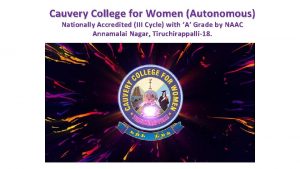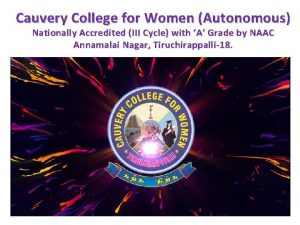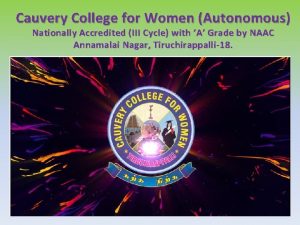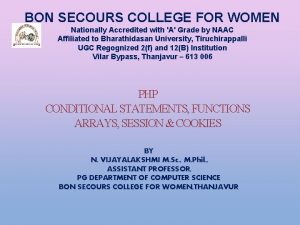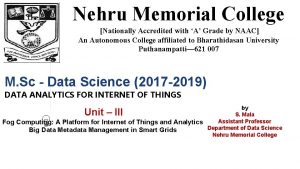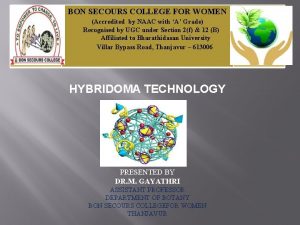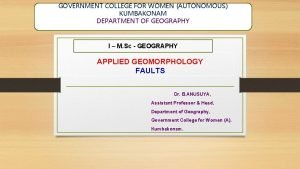Cauvery College for Women Autonomous Nationally Accredited III


















- Slides: 18

Cauvery College for Women (Autonomous) Nationally Accredited (III Cycle) with ‘A’ Grade by NAAC Annamalai Nagar, Tiruchirappalli-18. 1

Name of the Faculty Designation Department Contact Number Programme Batch Semester Course Code Unit Topics Covered : Ms D. RADHIKA : Asso Professor : Computer Science : 9629608765 : MSc Computer Science : 2016 -2017 Onwards : IV : Wireless Sensor Networks : P 16 CS 42 : V : Tossim, Tiny. GALS, Tiny OS, PIECES 2

Sensor Node Hardware Divided into 3 categories as § Augmented general purpose computers-uses real time operating systems and standard wireless protocols § Dedicated embedded sensor nodes provides simple sensor interfaces § System on Chip(So. C) build extremely low power 3

Berkeley Motes 4

Node level software platforms • Can be a node centric operating system, a language platform, provides library of components • Eg Tiny. OS, Tiny. GALS 5

6

Architecture of Tiny. OS 7

8

9

Tiny. GALS • Tiny. GALS is a globally asynchronous, locally synchronous model for programming event-driven embedded systems, especially sensor networks • At the local level, software components communicate with each other synchronously via method calls • Components are composed to form modules • At the global level, modules communicate with each other asynchronously via message passing, which separates the flow of control between modules 10

• A complementary model called Tiny. GUYS is a guarded yet synchronous model designed to allow thread-safe sharing of global state between modules without explicitly passing messages • The Tiny. GALS programming model is structured such that code for all intermodule communication, module triggering mechanisms, and access to guarded global variables can be automatically generated from a high level specification 11

12

13

TOSSIM • TOSSIM is a discrete event simulator for Tiny. OS sensor networks • Instead of compiling a Tiny. OS application for a mote, users can compile it into the TOSSIM framework, which runs on a PC • This allows users to debug, test, and analyze algorithms in a controlled and repeatable environment 14

As TOSSIM runs on a PC, users can examine their Tiny. OS code using debuggers and other development tools • TOSSIM’s primary goal is to provide a high fidelity simulation of Tiny. OS applications • While TOSSIM can be used to understand the causes of behavior observed in the real world, it does not capture all of them, and should not be used for absolute evaluations • 15

PIECES • Programming and Interaction Environment for Collaborative Embedded Systems • A software framework implements state centric programming to support modeling and simulation • Comprises of Principal and Port agents • A principal is maintaining the state • Also updates state from time to time • A port may be an input, output or both 16

PIECES Simulator • Simulates sensor network applications at high level • Combination of java and matlab • Java is to simulate message passing and agent execution • The signals, noise, target trajectories are simulated by Matlab 17

Thank You 18
 Cauvery college for women
Cauvery college for women Speed stacks spreads nationally in 1998.
Speed stacks spreads nationally in 1998. Hamlet act iii scene ii
Hamlet act iii scene ii Aapl accredited schools
Aapl accredited schools Accredited organization
Accredited organization Emirates authority for standardization and metrology logo
Emirates authority for standardization and metrology logo Naacls accredited cytogenetics education program
Naacls accredited cytogenetics education program Berkeley extension esl
Berkeley extension esl Ascld lab
Ascld lab What does it mean to be naeyc accredited
What does it mean to be naeyc accredited R.a 10912
R.a 10912 Bosch training academy
Bosch training academy Teta accredited providers list
Teta accredited providers list Cosma accredited schools
Cosma accredited schools Is old dominion university accredited
Is old dominion university accredited Oshs rule 1070
Oshs rule 1070 Ruckus certified partner
Ruckus certified partner Psgr krishnammal college
Psgr krishnammal college Autonomous buildings sustainability
Autonomous buildings sustainability





















